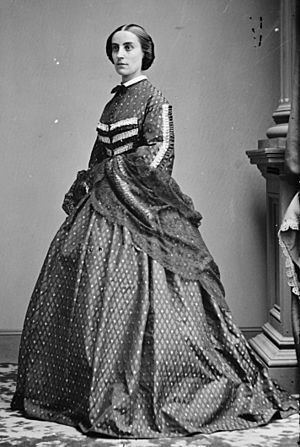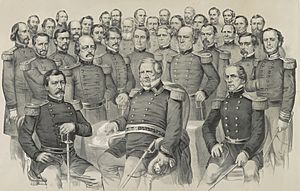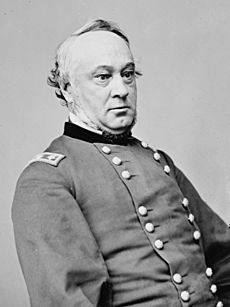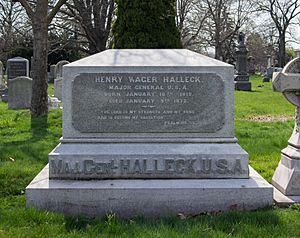Henry Halleck facts for kids
Quick facts for kids
Henry Halleck
|
|
|---|---|
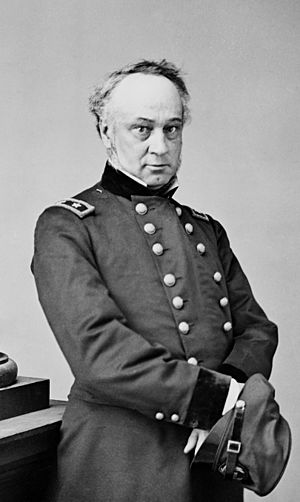
Halleck in uniform, c. 1865
|
|
| General in Chief of the Armies of the United States |
|
| In office July 23, 1862 – March 9, 1864 |
|
| President | Abraham Lincoln |
| Preceded by | George B. McClellan |
| Succeeded by | Ulysses S. Grant |
| Personal details | |
| Born |
Henry Wager Halleck
January 16, 1815 Westernville, New York, U.S. |
| Died | January 9, 1872 (aged 56) Louisville, Kentucky, U.S. |
| Resting place | Green-Wood Cemetery |
| Nickname | "Old Brains" |
| Military service | |
| Allegiance | |
| Branch/service | |
| Years of service | 1839–1854, 1861–1872 |
| Rank | |
| Commands |
|
| Battles/wars | Mexican–American War American Civil War |
Henry Wager Halleck (born January 16, 1815 – died January 9, 1872) was an important officer in the United States Army. He was also a smart scholar and a successful lawyer. People called him "Old Brains" because he was so knowledgeable about military topics.
Halleck played a big part in California becoming a state. During the American Civil War, he was a senior Union Army commander. He led Union operations in the Western Theater from 1861 to 1862. While Union armies in the East struggled, Halleck's troops won many key battles. However, he wasn't usually on the battlefield himself.
In July 1862, Halleck became the General in Chief of the Armies of the United States. He held this top position for about a year and a half. He was a careful general who liked to plan everything thoroughly. He was great at managing supplies and army organization. But he didn't control battles very well from his office in Washington, D.C. In March 1864, Ulysses S. Grant took over as general in chief, and Halleck became his chief of staff. In this role, he made sure the Union armies had everything they needed.
Contents
Henry Halleck: "Old Brains"
Early Life and Learning
Henry Halleck was born on a farm in Westernville, New York. He was the third of 14 children. Henry didn't want to be a farmer. He ran away from home and was raised by his uncle.
He went to Hudson Academy and Union College. Then he attended the United States Military Academy at West Point. He was a favorite student of military expert Dennis Hart Mahan. Halleck even taught classes while he was still a cadet. He graduated in 1839, ranking third in his class.
After West Point, he worked on improving defenses in New York Harbor. He wrote a report about coastal defenses that impressed General Winfield Scott. Scott sent Halleck to Europe in 1844 to study forts and the French military. When he returned, Halleck gave lectures that were later published as a book. This book, Elements of Military Art and Science, became an important guide for officers during the Civil War. His deep knowledge earned him the nickname "Old Brains."
A Career in California
During the Mexican–American War, Halleck was sent to California. He sailed around Cape Horn and translated a book about Napoleon's military strategies. This further boosted his reputation as a scholar.
He spent months building forts in California. He saw his first combat in November 1847 when the port of Mazatlán was captured. Halleck became the lieutenant governor of the occupied city. He was promoted for his brave service in California and Mexico.
Later, he worked for General Bennet Riley, the governor of the California Territory. Halleck became the military secretary of state. This meant he represented the governor at the 1849 meeting in Monterey, California. Here, the California state constitution was written. Halleck was one of the main authors of this important document.
He later joined a successful law firm in San Francisco. He became so busy and wealthy that he left the army in 1854. The next year, he married Elizabeth Hamilton, who was the granddaughter of Alexander Hamilton. They had one child, Henry Wager Halleck, Jr.
Halleck became very rich as a lawyer and by buying and selling land. He collected thousands of old documents about California's history. He also built the Montgomery Block, San Francisco's first fireproof building. By 1861, he was a major general in the California Militia.
The Civil War Begins
When the Civil War started, Halleck believed strongly in keeping the Union together. Because of his military knowledge, he was made a major general in the regular army in August 1861. This made him one of the highest-ranking generals.
He was sent to command the Department of the Missouri in St. Louis. He quickly brought order to the area, which had been very disorganized.
Leading in the West
Halleck had a difficult relationship with Ulysses S. Grant, who would later become a very successful general. Grant wanted to attack Confederate forts on the Tennessee and Cumberland Rivers. Halleck, who was a cautious general, at first said no.
But President Abraham Lincoln wanted action. So, Halleck changed his mind. Grant then led attacks on Forts Henry and Donelson in February 1862. He captured both forts and 14,000 Confederate soldiers. This was the Union's first big victory of the war.
Halleck's command did well in early 1862. They pushed the Confederates out of Missouri and into Arkansas. They also took control of parts of Tennessee. Many historians debate how much credit Halleck deserves for these victories. Some say his overall command was key. Others believe his subordinate generals, like Grant, were the main reason for the success.
In March 1862, Halleck's command grew to include more states. Grant's army was attacked at the Battle of Shiloh in April. Halleck then arrived to take personal command of his large army. He made Grant his second-in-command, which Grant felt was like being punished. Halleck then slowly moved his army toward Corinth, Mississippi. This was called the siege of Corinth. Halleck's army was twice the size of the Confederate force. He moved so carefully that the Confederates eventually left Corinth without a fight.
General in Chief
After a Union campaign failed in Virginia, President Lincoln called Halleck to Washington, D.C. He became the General in Chief of the Armies of the United States on July 23, 1862. Lincoln hoped Halleck would make his generals work together better and be more aggressive. But Lincoln was soon disappointed. He once called Halleck "little more than a first rate clerk."
In Washington, Halleck was excellent at managing the army's paperwork and supplies. He helped train, equip, and send thousands of soldiers across the country. But he wasn't good at commanding armies in the field or planning big strategies. His personality was cold and made his subordinate generals dislike him. Strong generals often ignored his advice.
For example, during the Northern Virginia Campaign in 1862, Halleck couldn't get General George B. McClellan to send help to General John Pope. This contributed to the Union defeat at the Second Battle of Bull Run. After this, Lincoln felt Halleck avoided responsibility.
Halleck argued that his generals in the East were too slow to attack General Robert E. Lee. Also, both Lincoln and Secretary of War Edwin M. Stanton often made military decisions themselves. Halleck saw himself as an advisor who had to follow orders, even if he disagreed.
Chief of Staff
On March 12, 1864, Ulysses S. Grant was promoted to lieutenant general and became the new General in Chief. Halleck was then made chief of staff. This meant he was in charge of the huge U.S. armies' administration. Grant and the War Department made sure to make this change easy for Halleck. They said he was relieved "at his own request."
Now that Grant was the aggressive general in the field, Halleck's skills in administration were very helpful. They worked well together. During the long campaigns of 1864, Halleck made sure Grant's armies had plenty of supplies, equipment, and new soldiers. This helped wear down the Confederates.
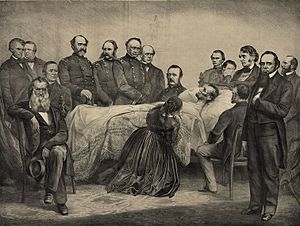
Halleck agreed with Grant and William T. Sherman about fighting a "hard war" against the Southern economy. He supported both Sherman's March to the Sea and General Philip Sheridan's destruction in the Shenandoah Valley. Halleck's ideas about military theory helped bring a new level of professionalism to the army.
After the War
After Grant forced Lee to surrender, Halleck was sent to command the military division in Richmond, Virginia. He was present when President Lincoln died and was a pall-bearer at Lincoln's funeral.
He later lost his friendship with General William T. Sherman. This happened because they argued about Sherman being too kind to former Confederates. In August 1865, Halleck was transferred to California. This was like a military exile. While there, he traveled with photographer Eadweard Muybridge to the newly purchased Russian America. He and Senator Charles Sumner are given credit for naming this region "Alaska". In March 1869, he was sent to command the military division in Louisville, Kentucky.
Henry Halleck became ill in early 1872 and died in Louisville. He is buried in Green-Wood Cemetery in Brooklyn, New York. A street in San Francisco and a statue in Golden Gate Park are named after him. He didn't leave behind any memoirs or personal letters. His wife, Elizabeth, later married Colonel George Washington Cullum. Cullum had worked on Halleck's staff during the war.
Namesakes
- Fort Halleck (1862–66): A military outpost in Dakota Territory. It protected travelers on the Overland Trail.
- Halleck, Nevada: A small community.
- Halleck Street in San Francisco near the Presidio.
- Halleck Cottage: A home at the San Francisco Protestant Orphanage, named after a donation.
In Popular Media
- Halleck appears as a character in some alternate history novels about the American Civil War.
- In the 1941 film They Died With Their Boots On, the character played by Sydney Greenstreet is partly based on Halleck.
- In the 1994 film Quiz Show, "Halleck" is the correct answer to a quiz question.
See also
 In Spanish: Henry Halleck para niños
In Spanish: Henry Halleck para niños
- List of American Civil War generals (Union)
- Halleck: Lincoln's Chief of Staff
Images for kids


